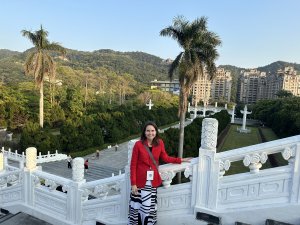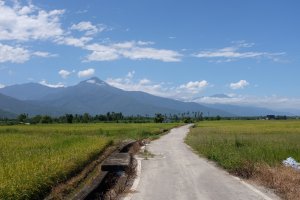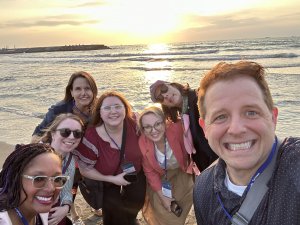During the 2016-2017 academic year, I am honored to have spent ten months at Academia Sinica’s Institute of Modern History while on a Fulbright grant for American graduate students (U.S. fellows). My Taipei-based project, A Chameleonic Power: The Republic of China’s Encounter with the Decolonizing World, 1942-1971, has been a component of my dissertation research in the field of diplomatic history. The overarching theme concerns the quiet advocacy of Nationalist Chinese statesmen at the height of the Cold War. During that period, representatives of the ROC journeyed to distant capitals in West Asia, Africa, Europe, and beyond in order to normalize relations of states and sub-national groups with the government in Taiwan, an island about which much of the world knew little. For this project, I have utilized the wealth of archival and library holdings open to foreign researchers in and around Taipei, and regret having to leave it all so soon.
When I arrived here last September, with only a piece of luggage plus a backpack, the first order of business was to quickly find a place to live. Having lived abroad for significant periods of time before entering graduate school, I can attest that the apartment rental process can be an extraordinary challenge in some countries. In Taiwan, I have found this not to be the case. Advertisements (mainly on major housing websites) were clear; terms were straightforward for a short-term lease; prices reasonable (I say so strictly as an American student from the Northeast Corridor linking New York and Washington, DC). Better still, on a modest budget I was pleased to find a rental overlooking one of the most scenic spots: Da’an Forest Park (大安森林公園).
I will comment on what it is about the Da’an Park that earns its popular nickname as “the lungs of the city.” But first, I am obliged to confess that as a young historian currently studying aspects of Taiwan’s modern history, when I saw the park for the first time on a visit a few years ago, my immediate questions were: How did this come to be here? And What was here before it? Surely this well-maintained public green space—one of the city’s largest and most popular—would reveal some details to satisfy such curiosities of this very far out-of-town visitor? I could not find answers on site.
When not working with materials at the Institute of Modern History in Nangang, my downtown base has been the National Central Library, the Taiwanese equivalent of the U.S. Library of Congress. There, I was able to track down the basics: The Second World War had disrupted the first large-scale project envisioned for the area by the Japanese municipal authorities in the 1930s. According to those plans, it was intended to take on the unimaginative title, “Park No. 7.” After the surrender of imperial armies to Chiang Kai-shek’s Republic of China, plans for this part of the municipality fell by the wayside from late 1945 until the retreat of ROC forces from the mainland in 1949-1950. (Current research by National Dong Hwa University professor Kang Pei-te illuminates changes to other aspects of urban space of this postwar phase. Notably, from 1946, many of Taipei’s major thoroughfares with Japanese names were dropped at the instruction of the newly occupying administrating authorities; names of Chinese war heroes, mainland cities, and nationalist slogans took their place.) At the end of 1949, the area that is today Da’an Forest Park was selected by Chinese Air Force senior officials as a base—not for aircraft, but as makeshift shelter for military personnel and their families having just fled the mainland. It is hard to imagine that a major juan cun or “military dependents’ village” once existed where today palm trees stand over well preserved walking paths and bicycle lanes. Within a decade, the village became open for general housing, where among other things the city government ordered construction of dormitories for overseas students from all over. An International House remained at Xinsheng South Road until the 1980s, on whose opposite side today stand the Taipei Grand Mosque (built 1958-60) as well as four Christian churches of different denominations. The park as we know it today—64 acres in size, about one eighth the size of Manhattan’s Central Park—officially opened to the public in March 1994, though the blueprints submitted to the City of Taipei trace the project back to the mid-1980s. Approval for the park space roughly coincided with the end of the island’s extended period of rule under martial law in 1987. Before that watershed, KMT authorities had been concerned that large public spaces in Taipei might become potential sites of political mobilization. The park’s redevelopment amid Taiwan’s transition towards multi-party democracy was, then, only the latest in a series since the area was surveyed by Japanese colonial officials three-quarters of a century ago.
I claim no expertise in urban planning or sustainable infrastructure. But, as a short-term resident, one of the things striking to me about Taipei City is its clear commitment to environmental care. One cannot help but be educated by Taiwanese whether regarding noise pollution, waste disposal, or concern for tidiness of pedestrian walking areas, no matter where one actually calls home. I reflect on my travels of the past year, downtown and on short excursions to far ends of the island, to Kaohsiung in the south, and to Tamsui and Jiufen, both short rides from the capital in the north. Definitely, the institutional and individual ethic of huanjing baohu (environmental protection) is most inspiring and admirable, no matter the circumstances of finite land and energy resources which led Taiwanese to take actions in this policy area.
Da’an Forest Park, the city’s largest, embodies this everyday environmentalism at the heart of a bustling city. A few paces from the heavy car traffic at the intersection of Xinsheng South Road (Sec. 2) and Xinyi Road (Sec. 3), there is a so-called bamboo zone (zhulin qu) with multiple plant species. Each is tagged, presumably for specialist tracking, and marked for visitors, with the Chinese and Latin names. Fallen leaves and branches by this main entrance are used as natural compost, according to the Park Services website. Nearby, passers-by demonstrate their respect to the large statue of Guanyin, the imposing bodhisattva familiar to Buddhists from Shanghai to Singapore. In this northwest corner of the park, she is greeted at all hours. About eighty yards further, an artificial island and pond of less than two acres has become a natural preserve for migrating geese and egrets. These and two dozen other non-human residents are individually identified for visitors in illustrated signs in three languages. The pond is a hands-down favorite for amateur photographers, this writer included. In a separate area towards to center, it is explained that the park has an innovative underground system where water from rainfall, which has not been infrequent this year, is pushed to the four corners of the park. This, like its solar-powered lamp posts, eliminate need for Da’an Forest Park to put much burden on the wider utility system.
As a public space that never closes, neighbors utilize the park space day and night. Using the jogging paths after dawn, the most common sight at early hours are the large groups of people practicing tai chi, typically coordinated with traditional background music from a portable radio. At noontime, construction workers and caregivers take their lunch breaks in the empty seats of the park’s amphitheater. (Since I arrived, this venue has been host to at least five free public concerts—including a multi-day symphony orchestra series for Christmas and New Year’s.) In the afternoons, especially on weekends, parents sit on blankets alongside dozens of child-sized tents pitched across the grass, which is a colorful if unfamiliar sight; particularly so given more often than not, it is dogs, not babies, who are inside them. (Taipei is a very dog-friendly town.) Late into the evenings when the temperature drops, high school and college students use the park’s basketball courts under overhead lights. No one pretends to be going pro; with a pair of athletic shoes, it has been easy for local Fulbrighters to join the action.
With my Fulbright residency winding down, I am beginning to pack my bags for the return trip back to the U.S. a few weeks from now. When I look back someday, among the memorable aspects of my ten-month stay in Taiwan’s capital, the hours spent roaming in my adopted backyard will surely be one of them.





